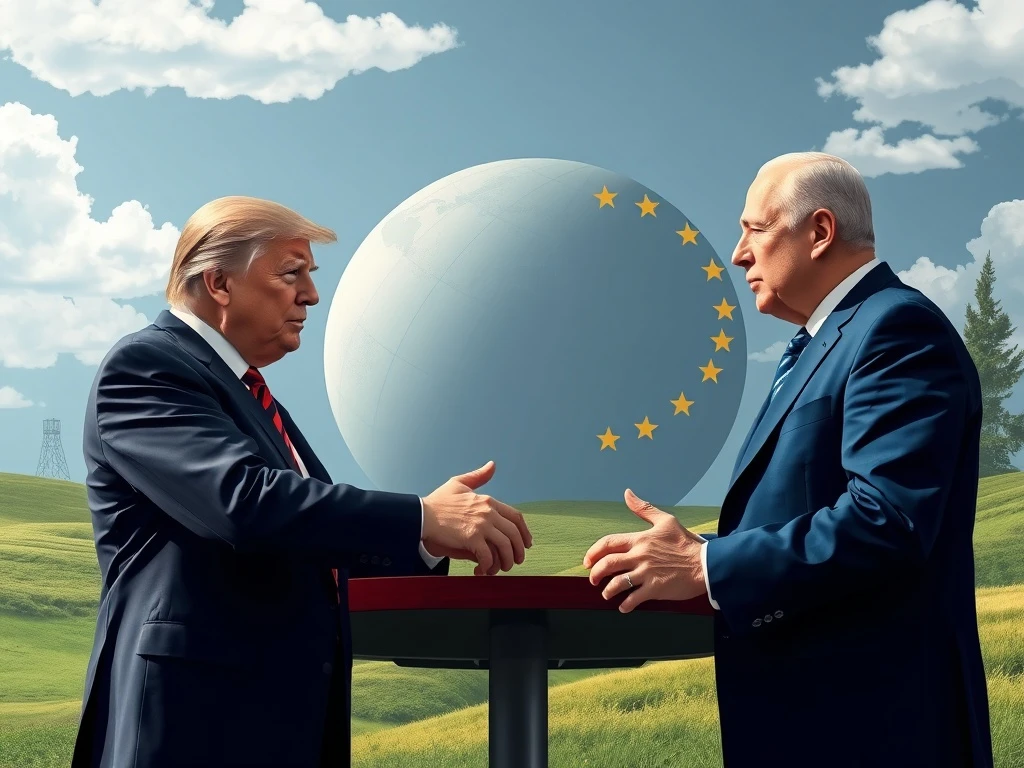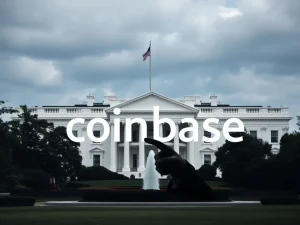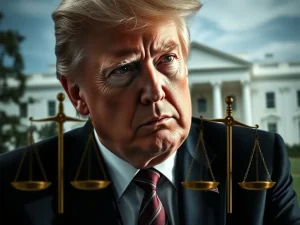Urgent Showdown: Trump Demands Tariff Cut as US EU Trade Deal Hangs in Balance

In the fast-paced world of cryptocurrencies, market sentiment often hinges on global economic stability. Major geopolitical events, like the intense trade negotiations between the United States and the European Union, can send ripples across traditional financial markets, inevitably influencing the volatile crypto landscape. As President Donald Trump doubles down on his demands for significant tariff cuts, the fate of a crucial US EU trade deal hangs precariously, creating an atmosphere of uncertainty that savvy crypto investors are closely watching.
The Looming US EU Trade Showdown
President Donald Trump has once again asserted a firm stance: the European Union must significantly reduce its 30% tariff on U.S. goods to secure a trade agreement. This condition, termed a “buy down” requirement, highlights the administration’s strategic use of tariffs as leverage. Speaking before a trip to Scotland, Trump put the odds of a U.S.-EU deal at a stark “50-50” or even lower, underscoring Washington’s unyielding position on tariff reductions. The proposed 30% levy, initially announced in July 2025, targets key European exports, including French cheese, Italian leather, and German electronics.
Understanding the Trump Tariffs Strategy
Trump’s demand for a 30% tariff reduction aligns with his administration’s broader strategy of employing substantial tariffs to reshape trade relations. This approach seeks to compel trading partners to offer significant concessions. While the specific concessions the EU must make remain undefined, U.S. officials suggest the bloc needs to offset the tariff burden, possibly through trade concessions or financial mechanisms, to avoid reciprocal duties. This strategy echoes the U.S.-Japan agreement, where Japan committed to investments in exchange for tariff reductions. However, EU diplomats have signaled no intention of replicating such terms, complicating the current Trump tariffs negotiations.
What’s at Stake for the Crucial Trade Deal?
The European Commission has made preventing the 30% tariff its top priority. European Commission President Ursula von der Leyen is set to meet with Trump in Scotland to address the impasse. Both sides face immense pressure to resolve the dispute before August 1, when the tariffs are scheduled to take full effect. EU trade officials have voiced criticism over what they perceive as shifting U.S. positions, including Trump’s abrupt reversal in July of a ban on steel and aluminum imports—a key demand in prior EU negotiations. The potential failure of this trade deal carries high stakes, impacting not only bilateral commerce but also broader economic stability.
The Imminent Threat of EU Retaliation
In response to the U.S. demands, the EU has prepared extensive retaliatory tariffs, exceeding €93 billion ($109 billion) on American imports, should negotiations collapse. This robust measure signals the EU’s resolve to avoid unilateral concessions and protect its economic interests. White House trade adviser Peter Navarro has cautioned against optimism regarding the EU’s public statements on compromise, emphasizing the unpredictable nature of Trump’s negotiations. The threat of significant EU retaliation underscores the seriousness of the dispute and the potential for a full-blown trade war if an agreement is not reached.
Broader Implications for Global Trade Dynamics
Trump’s 50-50 assessment of a deal suggests a readiness to abandon negotiations if the EU fails to meet his terms, a stance that could further strain transatlantic relations. The implications extend beyond tariffs, reflecting Trump’s emphasis on economic nationalism and skepticism of multilateral agreements. During his remarks, he also reiterated calls for the EU to limit immigration and reduce reliance on wind power, framing these as interconnected with trade priorities. This multifaceted approach highlights the administration’s focus on reshaping U.S. economic policy through bilateral negotiations rather than multilateral frameworks. The outcome of the Trump-von der Leyen meeting is pivotal. A failure could escalate tensions with the EU, the U.S.’s largest trade partner, and disrupt global supply chains. Conversely, a successful deal would demonstrate the Trump administration’s ability to blend punitive measures with pragmatic economic incentives—a model that could influence future global trade negotiations.
Frequently Asked Questions (FAQs)
1. What is the main point of contention in the US-EU trade talks?
The primary point of contention is President Trump’s demand for the European Union to reduce its 30% tariff on U.S. goods as a condition for a trade agreement.
2. What does Trump mean by a “buy down” requirement?
A “buy down” requirement implies that the EU must offer significant concessions, possibly through trade benefits or financial mechanisms, to offset the tariff burden and avoid reciprocal duties from the U.S.
3. What is the EU’s prepared response to the proposed tariffs?
The EU has prepared retaliatory tariffs exceeding €93 billion ($109 billion) on American imports, ready to be implemented if negotiations fail and the U.S. tariffs take effect.
4. Why is the August 1 deadline significant for these trade negotiations?
The August 1 deadline is crucial because it is the date when the proposed 30% U.S. tariffs on European exports are set to take full effect, escalating the trade dispute if no agreement is reached before then.
5. How might these trade tensions impact global markets, including cryptocurrencies?
Increased trade tensions can create significant uncertainty in traditional financial markets, leading to investor apprehension. This uncertainty often spills over into the cryptocurrency market, which is sensitive to macroeconomic shifts and overall market sentiment, potentially leading to increased volatility or price movements.
6. Beyond tariffs, what other demands has Trump linked to trade negotiations?
Beyond tariff reductions, Trump has also linked non-trade issues to the negotiations, including calls for the EU to limit immigration and reduce its reliance on wind power, framing these as interconnected with his broader economic and political priorities.








